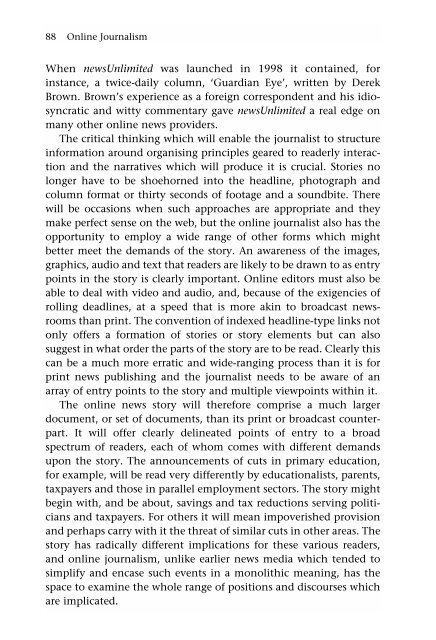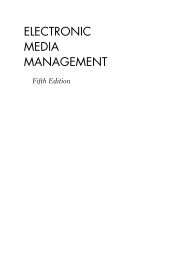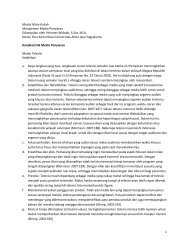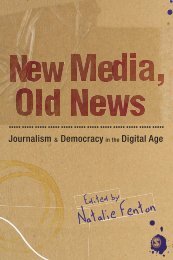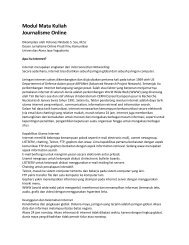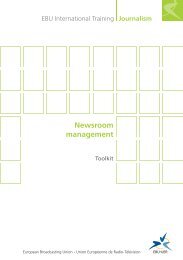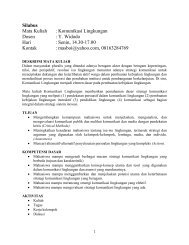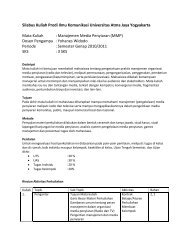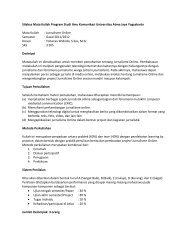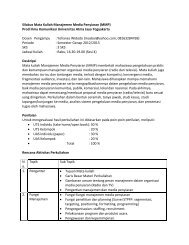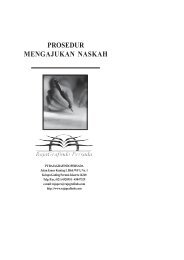Online Journalism - Ayo Menulis FISIP UAJY
Online Journalism - Ayo Menulis FISIP UAJY
Online Journalism - Ayo Menulis FISIP UAJY
You also want an ePaper? Increase the reach of your titles
YUMPU automatically turns print PDFs into web optimized ePapers that Google loves.
88 <strong>Online</strong> <strong>Journalism</strong><br />
When newsUnlimited was launched in 1998 it contained, for<br />
instance, a twice-daily column, ‘Guardian Eye’, written by Derek<br />
Brown. Brown’s experience as a foreign correspondent and his idiosyncratic<br />
and witty commentary gave newsUnlimited a real edge on<br />
many other online news providers.<br />
The critical thinking which will enable the journalist to structure<br />
information around organising principles geared to readerly interaction<br />
and the narratives which will produce it is crucial. Stories no<br />
longer have to be shoehorned into the headline, photograph and<br />
column format or thirty seconds of footage and a soundbite. There<br />
will be occasions when such approaches are appropriate and they<br />
make perfect sense on the web, but the online journalist also has the<br />
opportunity to employ a wide range of other forms which might<br />
better meet the demands of the story. An awareness of the images,<br />
graphics, audio and text that readers are likely to be drawn to as entry<br />
points in the story is clearly important. <strong>Online</strong> editors must also be<br />
able to deal with video and audio, and, because of the exigencies of<br />
rolling deadlines, at a speed that is more akin to broadcast newsrooms<br />
than print. The convention of indexed headline-type links not<br />
only offers a formation of stories or story elements but can also<br />
suggest in what order the parts of the story are to be read. Clearly this<br />
can be a much more erratic and wide-ranging process than it is for<br />
print news publishing and the journalist needs to be aware of an<br />
array of entry points to the story and multiple viewpoints within it.<br />
The online news story will therefore comprise a much larger<br />
document, or set of documents, than its print or broadcast counterpart.<br />
It will offer clearly delineated points of entry to a broad<br />
spectrum of readers, each of whom comes with different demands<br />
upon the story. The announcements of cuts in primary education,<br />
for example, will be read very differently by educationalists, parents,<br />
taxpayers and those in parallel employment sectors. The story might<br />
begin with, and be about, savings and tax reductions serving politicians<br />
and taxpayers. For others it will mean impoverished provision<br />
and perhaps carry with it the threat of similar cuts in other areas. The<br />
story has radically different implications for these various readers,<br />
and online journalism, unlike earlier news media which tended to<br />
simplify and encase such events in a monolithic meaning, has the<br />
space to examine the whole range of positions and discourses which<br />
are implicated.


